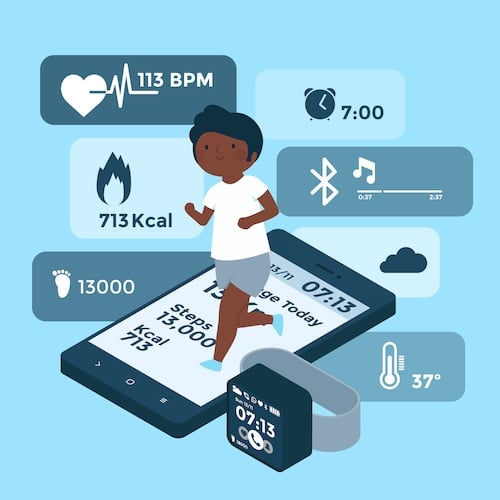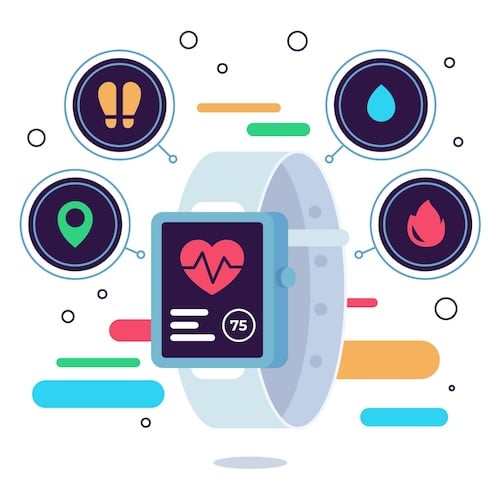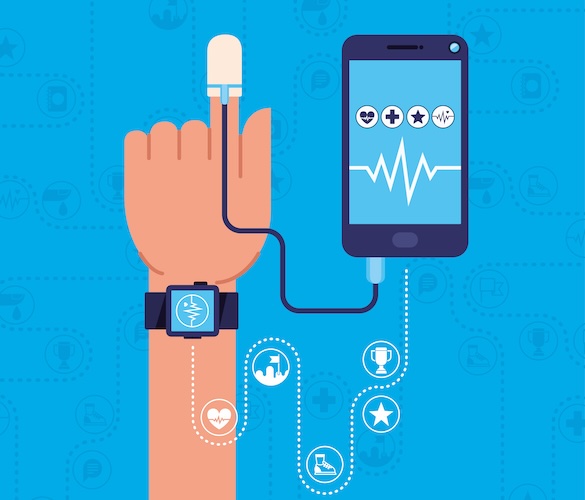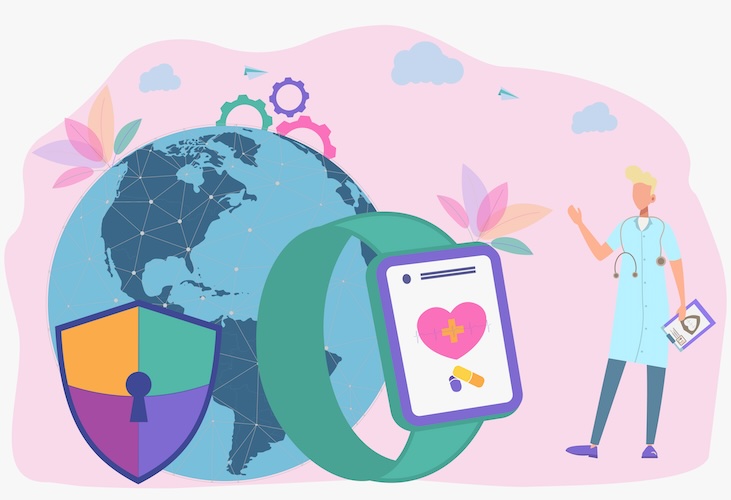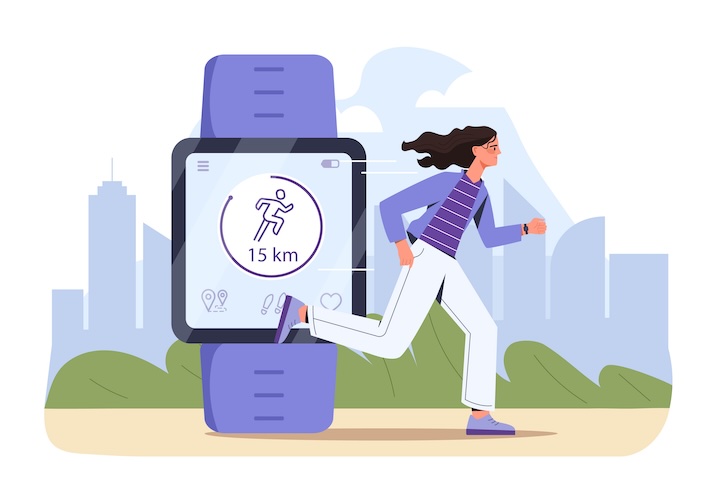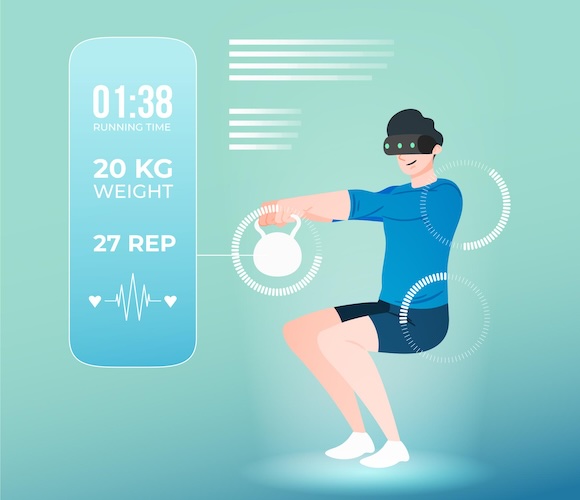Remember when fitness trackers only counted steps and monitored sleep? Today, digital health wearable technology, including patient wearable devices, can detect irregular heart rhythms, monitor glucose levels in real time, and even predict seizures. And it doesn’t stop there.
Wearable tech blurs the line between consumer electronics and medical devices. It’s not just about fitness tracking. It’s about preventive healthcare, continuous monitoring, and empowering patients to take control of their health through personalized data-driven decisions.
Of course, there are challenges. Ensuring data accuracy, securing patient information, affordability, and regulatory compliance are hurdles to widespread adoption. But the rewards outweigh the risks.
In this blog, we’ll share insights, experiences and explore different types of health wearable technology, discussing benefits, challenges, and the future of wearable devices in medicine.
Top Takeaways:
- Wearable technology and healthcare are intertwined for the future: Wearable technology is not just a trend but a significant tool transforming healthcare. It’s empowering individuals to take charge of their health through real-time monitoring and personalized data-driven decisions.
- Revolutionizing the medical field with wearable technology: The impact of wearable technology in the medical field is profound. It provides continuous monitoring of vital signs, enabling healthcare providers to make data-driven decisions. Could this be the key to more effective and personalized healthcare?
- The future is promising with advancements in wearable technology: From predictive wearables to smart clothing and implants, the future of wearable technology in healthcare is bright and revolutionary.
Table of Contents:
- What is Wearable Technology in Healthcare?
- The Importance of Wearable Health Monitoring Devices in Transforming Healthcare
- Exploring the Different Types of Wearable Technology in Healthcare
- Harnessing the Benefits of Wearable Technology in Healthcare
- Overcoming Wearable Health Technology Challenges and Limitations
- Future of Wearable Technology in Healthcare
- Case Studies: Success Stories of Wearable Health Tech
- Topflight’s Experience in Medical Wearables
What is Wearable Technology in Healthcare?
Wearable technology in healthcare refers to electronic devices worn on the body that collect, transmit, and sometimes analyze health data in real time for clinical or personal use.
The Importance of Wearable Health Monitoring Devices in Transforming Healthcare
Health wearables are leading a revolution in the healthcare industry. These wearable health monitor devices have initiated a proactive approach to health management by providing real-time monitoring of various health conditions.
The Crucial Role of Wearable Technology in the Healthcare Sector
Wearable healthcare technology has become an essential component of modern healthcare, enabling the continuous capture of biometric signals and delivering valuable health information in real time. These devices are not only reshaping preventive care—they’re also improving patient outcomes by supporting data-driven decision-making across clinical workflows.
For example, wearables equipped with electrocardiograph (EKG) sensors can monitor a patient’s heart activity continuously, making it possible to detect arrhythmias or abnormalities before they escalate. This kind of real-time tracking is transforming how care teams manage risk and respond to acute events.
In short, wearable healthcare technology is redefining care delivery—turning passive data into actionable insights that fuel faster decisions and smarter interventions.
Evolution from Simple Fitness Trackers to Advanced Medical Devices
The journey of health wearables has been transformative. From simple devices for tracking physical activity to advanced medical tech that monitors vital signs, sleep patterns, and more, this evolution has been instrumental in improving health outcomes and promoting preventive healthcare.
Taking a giant leap in this evolution, Elon Musk’s Neuralink has recently implemented the first brain implant. This groundbreaking development opens up possibilities for treating neurological disorders and paving the way for potential advancements in cognitive enhancement.
Today’s health wearable devices include a wide range of body monitoring products, from wrist-based trackers to implantable biosensors, each playing a growing role in clinical care.
Read more on medical device integration and medical device software development
Integration of AI and Machine Learning in Wearables
AI and Machine Learning have taken wearable healthcare technology a notch higher. These advancements allow for predictive analytics and personalized insights, facilitating early disease detection and preventive healthcare. Here are some exciting stats:
- By 2029, the global market for AI in healthcare is expected to reach USD 148 billion.
- Wearable devices are predicted to reduce hospital costs by 16% in the next five years.
- About 88% of healthcare providers are investing in remote patient monitoring solutions.
These advances in wearable technology necessitate a comprehensive approach to wearable app development, interweaving hardware and software to collect and analyze biometric data while ensuring flawless user experience.
Exploring the Different Types of Wearable Technology in Healthcare
Healthcare wearables have evolved beyond simple step-counting devices. Today, these medical wearable devices offer a diverse range of applications, offering everyone from fitness enthusiasts to patients with chronic conditions a way to monitor and improve their health.
As a healthcare professional, you’re well aware of the possibilities that these devices offer to providers. They enhance patient care with accurate diagnostics and simplified health data management, revolutionizing healthcare providers’ toolkit for personalized and efficient care.
In this section, we’ll break down the most impactful categories of wearable health tech in clinical use today:
- fitness trackers
- smartwatches and health bands
- wearable ECG and cardiac monitors
- smart health clothing
- biosensors and implantables
- chronic disease management wearables
- hospital-grade wearables
- mental health-focused neuromodulation devices
Fitness Trackers: Beyond Steps Counting
What it consists of: Fitness trackers are lightweight, wrist-worn healthcare trackers equipped with motion sensors (accelerometers, gyroscopes), optical heart rate monitors, and often GPS modules. Many models include Bluetooth connectivity for syncing with health monitoring apps and cloud platforms.
What data it gathers: These devices monitor a range of vital health metrics—counting steps, tracking heart rate, analyzing sleep quality, and logging physical activity intensity, calorie burn, and in some cases, blood oxygen levels.
What purpose it serves: As essential tools in both consumer wellness and clinical preventive care, fitness trackers encourage physical activity, support cardiac health awareness, and empower users with continuous personal health data. They’re increasingly used in outpatient programs, post-discharge recovery, and workplace wellness initiatives.
Example device: The Fitbit Charge 6 combines step tracking, ECG functionality, SpO2 monitoring, and advanced sleep analysis—bridging lifestyle tracking with wearable technology for health monitoring.
Also Read: Fitness Tracking App Development Guide
Smartwatches and Health Bands: Your Health Companion
What it consists of: Smartwatches and smart health bands are multi-functional wearable devices featuring touchscreen displays, optical sensors, accelerometers, gyroscopes, and wireless modules (Bluetooth, Wi-Fi, LTE). Many models are built with medical-grade components, including ECG sensors and blood oxygen monitors.
What data it gathers: These devices track physical activity, continuously monitor vital signs such as heart rate, blood oxygen saturation, skin temperature, and sleep cycles. Some models also detect falls or irregular heart rhythms, offering proactive alerts.
What purpose it serves: Smartwatches serve as comprehensive wearable medical devices, bridging lifestyle and clinical use cases. They support remote patient monitoring, detect early signs of cardiac events, and sync seamlessly with mobile health apps and EHR systems. Their real-time feedback loop empowers users and providers to stay ahead of acute and chronic conditions.
Example device: The Apple Watch Series 9 exemplifies the category with built-in ECG, SpO2 monitoring, and fall detection, making it a clinically impactful tool that goes far beyond step counting.
Wearable ECG and Cardiac Monitors: Heart Health at Your Fingertips
What it consists of: Wearable ECG monitors are compact healthcare wearables equipped with medical-grade electrocardiogram sensors, typically integrated into patches, wristbands, or chest straps. They often include Bluetooth or LTE connectivity to transmit heart data to mobile apps or provider platforms in real time.
What data it gathers: These devices enable continuous heart rate monitoring, capturing detailed ECG waveforms and detecting arrhythmic events such as atrial fibrillation, bradycardia, or tachycardia. Some models also track respiration rate and heart rate variability for a more comprehensive cardiovascular profile.
What purpose it serves: Used for detecting cardiac abnormalities outside clinical settings, wearable ECGs support remote diagnostics, early intervention, and ongoing management of heart disease. They offer real-time heart health information that can be truly life-saving, especially for high-risk or post-surgical patients.
Example device: The Zio Patch is a widely adopted wearable ECG monitor, offering up to 14 days of continuous cardiac monitoring with cloud-based analytics for clinicians.
Don’t miss our comprehensive guide on heart app development, where we explore the nuances of creating apps that can truly make a difference in cardiovascular health management.
Smart Health Clothing and Textile
What it consists of: Smart health clothing includes sensor-embedded workout gear and sleepwear designed with textile-based biosensors woven directly into the fabric. These garments are wirelessly connected to mobile apps or monitoring systems, enabling real-time health tracking during daily routines.
What data it gathers: This wearable category captures physiological signals such as heart rate, respiration rate, movement patterns, and body temperature. Some garments also measure posture or muscle activation for more specialized use cases.
What purpose it serves: By enabling users to track vital stats passively during day-to-day activities, smart clothing provides seamless, non-intrusive monitoring for wellness, sleep optimization, athletic performance, and even remote rehabilitation. In clinical settings, they’re being explored for long-term monitoring of respiratory or cardiovascular conditions.
Example device: The Hexoskin Smart Shirt collects a full suite of biometric data including ECG, breathing rate, and sleep metrics—making it ideal for both researchers and remote patient monitoring programs.
Related: Create a sleep tracking application
Biosensors and Implantables: The Invisible Health Protectors
What it consists of: Biosensors and implants are miniaturized, often internally placed medical wearables designed for invasive monitoring. These devices are embedded under the skin or ingested, and typically include microelectronic sensors, transmitters, and biocompatible materials to ensure long-term use inside the body.
What data it gathers: They measure critical health parameters such as glucose levels in diabetes patients, or cardiac function in heart disease patients. Depending on the device, they may also collect data on core body temperature, blood chemistry, or neural signals.
What purpose it serves: Often considered the best medical wearables for high-risk or chronic conditions, biosensors deliver real-time data to clinicians or patient apps. This continuous insight enables proactive health management, allowing earlier interventions and reducing emergency events in both outpatient and hospital settings.
Example device: The Dexcom G7 is a top-tier continuous glucose monitor offering real-time readings without the need for finger pricks, helping people with diabetes maintain tighter control and reduce complications.
Also Read: A Guide to IoT App Development
Wearable Tech for Chronic Disease Management
What it consists of: This category of wearable tech includes disease-specific devices such as glucose monitors for diabetics, wearable ECG patches for cardiac patients, smart inhalers for asthma, and seizure-detection headbands for epilepsy. These wearables often pair with mobile apps or clinical dashboards to share data with care teams in real time.
What data it gathers: Depending on the condition, these devices monitor blood glucose levels, respiratory patterns, cardiac rhythms, or seizure precursors. They’re designed to flag abnormalities or deviations from baseline health markers.
What purpose it serves: By enabling continuous health tracking and alerting both patients and healthcare providers to anomalies, these wearables support earlier diagnosis and timely intervention—reducing hospitalizations and improving chronic care outcomes. They are especially impactful for patients managing conditions that can escalate quickly without visible symptoms.
Example device: The FreeStyle Libre 3 is a next-generation glucose monitoring system for diabetics, providing real-time readings and low/high glucose alerts directly to smartphones for proactive disease management.
Also Read: Move to Earn App Development Guide
Hospital-Grade Wearables (Inpatient Monitoring)
What it consists of: Hospital-grade wearables are FDA-cleared medical devices such as adhesive smart patches, wristbands, or biosensor modules designed specifically for use in inpatient settings. These devices integrate with hospital systems and typically include ECG sensors, temperature probes, pulse oximeters, and wireless connectivity for centralized monitoring.
What data it gathers: They capture high-frequency clinical data such as heart rate, respiratory rate, oxygen saturation, skin temperature, and sometimes motion or posture data. Some devices also detect early signs of sepsis, infection, or patient deterioration.
What purpose it serves: These wearables support continuous monitoring of admitted patients, helping clinical staff detect acute changes earlier without the need for frequent manual checks. They enhance patient safety, reduce alarm fatigue, and support data-driven workflows in ICU, med-surg, and post-operative units.
Example device: The Masimo Radius T is a wireless, wearable temperature sensor used in hospitals for real-time fever monitoring and remote patient surveillance—offering an extra layer of protection in infectious disease protocols and post-op recovery.
Wearable Neuromodulation and Mental Health Devices
What it consists of: These wearable devices include headbands, patches, and earbuds equipped with low-frequency electrical or vibrational stimulators targeting neural pathways. Most use transcutaneous electrical nerve stimulation (TENS), transcranial electrical stimulation (tES), or biofeedback sensors. They often pair with mobile apps for therapy tracking and user feedback.
What data it gathers: They monitor stress markers such as heart rate variability, sleep quality, and brainwave activity. Some devices also collect user-reported mood or symptom data to guide therapy adjustments.
What purpose it serves: Used to manage anxiety, depression, migraine, ADHD, and PTSD, these devices offer non-pharmacological mental health support and proactive health management. They’re gaining traction as adjunct therapies in digital behavioral health, neurorehab, and remote mental health treatment models.
Example device: The Cove wearable uses gentle vibrations behind the ears to activate the parasympathetic nervous system, helping reduce stress and improve sleep—validated through clinical studies and increasingly adopted in workplace wellness and psychiatry settings.
Harnessing the Benefits of Wearable Technology in Healthcare
The benefits of wearable technology in healthcare are multifaceted and substantial. From continuous monitoring to preventive healthcare, these devices are changing healthcare, providing valuable health data that empowers patients and healthcare providers alike.
Among the latest trends in digital care, smart wearables for health monitoring are playing a central role in enabling scalable telemedicine and remote diagnostics.
Below, we’ll explore six key benefits driving adoption of wearable health tech:
- Continuous Monitoring
- Preventive Healthcare
- Patient Empowerment
- Data-Driven Decisions
- Remote Patient Monitoring
- Personalized Healthcare
Continuous Monitoring: Always On, Always Vigilant
One of the primary benefits of wearable devices in healthcare is their ability to provide continuous monitoring. These devices, equipped with various sensors, can track a wide range of health parameters 24/7. Whether it’s heart rate, blood pressure, or sleep patterns, this constant vigilance provides a wealth of health data, enabling early detection of potential health issues.
This constant data stream enables:
- Early detection of clinical deterioration
- Reduction of preventable ER visits
- Proactive management of chronic diseases
Also Read: Fitness App Development Guide
Preventive Healthcare: Nipping Diseases in the Bud
Preventive healthcare is another significant impact of wearable technology in healthcare. By incentivizing health-focused behavior, wearables can help reduce hospital visits and readmissions due to poorly managed personal health.
They support:
- Risk stratification for chronic illness
- Timely alerts to providers on biometric anomalies
- Continuous screening for early-stage symptoms
This proactive approach, backed by real-time health data, allows for earlier clinical intervention and better population health management, nipping diseases in the bud.
Patient Empowerment: Taking Control of Health
Wearable technology empowers patients to take control of their health and wellness. With access to personalized health data, individuals can make informed decisions about their lifestyle and medical care. Furthermore, wearables can motivate users to adopt healthier habits, bringing about a positive change in their overall well-being.
Benefits include:
- Improved patient adherence to treatment
- Increased engagement in disease self-management
- Behavior change supported by real-time feedback
For example, patients with hypertension can monitor their blood pressure trends and adjust lifestyle factors accordingly—without waiting for the next appointment.
Data-Driven Decisions: Making Informed Choices
Healthcare providers can leverage the wealth of health data generated by wearables to make data-driven decisions. This real-time information allows for personalized treatment plans, improving patient outcomes. Furthermore, this data can be integrated into Electronic Health Records (EHR), providing a comprehensive view of the patient’s health.
Advantages include:
- Tailored treatment plans based on real-world data
- Integration with EHRs for longitudinal analysis
- Improved care coordination across multi-disciplinary teams
This helps providers optimize patient outcomes and transition from reactive care to predictive, precision medicine.
Remote Patient Monitoring: Healthcare from a Distance
The advent of wearable technology in healthcare has made remote patient monitoring a reality. Healthcare providers can now monitor patients’ health from a distance, making healthcare more accessible. This is particularly beneficial for patients residing in remote areas or those unable to visit healthcare facilities frequently.
RPM wearables are essential for:
- Managing post-acute care
- Monitoring chronic conditions like COPD or diabetes
- Supporting rural and underserved populations with limited access to care
Also Read: RPM App Development Guide
Personalized Healthcare: Tailored to the Patient’s Needs
Personalized healthcare is one of the key benefits of wearable tech in healthcare. These medical devices can enable personalized and continuous monitoring of vital signs, allowing for tailored healthcare solutions. By understanding an individual’s unique health profile, healthcare providers can provide more effective and efficient care.
Benefits include:
- Continuous monitoring of individual health profiles
- Precision interventions guided by longitudinal biometric data
- Enhanced ability to deliver outcome-based care at scale
With the surge in wearable technology, the opportunity to create a healthcare app that seamlessly integrates with these medical devices is tremendous, opening doors to tailored healthcare solutions and fostering an environment where technology and health go hand in hand.
Read more on medical device cost breakdown
Overcoming Wearable Health Technology Challenges and Limitations
While wearable health monitoring devices have undoubtedly revolutionized healthcare, they come with their own set of challenges and limitations. The top wearable health devices on the market today are continuously evolving to address these issues, striving to offer reliable, accessible, and user-friendly solutions.
To fully harness the potential of wearable health monitoring devices, developers and manufacturers must overcome a range of implementation challenges. These include:
- securing patient data
- ensuring accuracy and reliability
- improving affordability
- navigating regulatory compliance
- designing seamless user experiences
- tailoring solutions to diverse clinical and consumer use cases
- addressing battery life and comfort constraints
Securing Patient Data: HIPAA and SaMD Regulations by FDA
As more and more people embrace medical monitoring devices, the security of patient data has become a paramount concern. With laws like the Health Insurance Portability and Accountability Act (HIPAA) and Software as a Medical Device (SAMD) guidelines by the FDA, patient privacy is no longer an option but a mandate.
Also Read: HIPAA Compliant App Development Guide
But how can manufacturers ensure data security? Here are a few strategies:
- Data Encryption: Encrypting data both at rest and in transit can significantly reduce the risk of data breaches.
- Regular Audits: Conducting regular audits can help identify potential vulnerabilities and address them promptly.
- User Authentication: Implementing robust user authentication protocols can prevent unauthorized access to patient data.
When it comes to HIPAA compliance and SaMD regulations, consulting a seasoned healthcare app development company is essential. These measures are essential for maintaining data integrity across remote patient monitoring systems and ensuring regulatory-grade protection of protected health information (PHI).
Ensuring Accuracy and Reliability in Wearable Tech
Accuracy and reliability are crucial when it comes to wearable computers in healthcare. Inaccurate data can lead to misdiagnosis or incorrect treatment, potentially endangering patients’ lives. Manufacturers must, therefore, ensure that their devices are meticulously calibrated and regularly tested for precision.
To ensure clinical-grade accuracy, manufacturers are prioritizing:
- Device calibration for consistency across patient populations
- Rigorous quality assurance aligned with ISO medical device standards
- Real-world clinical validation in ambulatory and inpatient settings
Making Wearable Tech Accessible and Affordable
Despite the growing use of wearable health technology, cost remains a significant barrier. Many high-end devices are priced out of reach for the average consumer, limiting their accessibility. Manufacturers need to strike a balance between offering advanced features and maintaining affordability to ensure broader adoption.
Broader adoption also depends on how well cost-effective devices integrate with payer models, population health programs, and value-based care frameworks.
Meeting Regulatory Compliance in Wearable Tech
Wearable health monitoring sensors must meet a host of regulatory standards, from safety certifications to medical device approvals. Navigating these complex regulations can be challenging but is crucial for ensuring the safe and effective use of these devices.
Compliance efforts span across FDA Class I–III classifications, CE marking for EU markets, and adherence to interoperability standards such as HL7 and FHIR where applicable.
Creating Seamless User Experience: Integration with Apps, Cloud Storage, and More
A seamless user experience is critical to the adoption and sustained use of medical wearable technology. From setup to daily use, patients and clinicians alike expect devices that offer intuitive interfaces, minimal friction, and dependable data backup via cloud storage.
To ensure ease of use, developers must prioritize:
- Integration with smartphone apps for real-time syncing
- Cross-platform optimization that respects hardware peculiarities across different platforms
- Clear, responsive intuitive design tailored for each user type
Effective customer support and proactive UX testing further enhance engagement. Ultimately, the more user-friendly a wearable device is, the more likely it is to become a trusted part of clinical workflows and patient routines.
Tailoring Wearable Tech for Various User Scenarios
Wearable software must adapt to a range of user scenarios—from ambulatory patients at home to hospital-based staff managing critical care. For developers, this means designing flexible front-end experiences that fit the needs of diverse clinical users.
A typical wearable app may function well on a smartphone, but some workflows require a tablet interface for better visualization of health analytics or a robust web application to support care team dashboards. Whether data is viewed on a wrist, in a pocket, or at a nursing station, the UI must be clinically aware, intuitive, and responsive to the demands of the user segment it serves.
Tackling Battery Life and Comfort: The Unseen Challenges
Battery limitations can disrupt continuous health data streams, compromising the reliability of longitudinal monitoring in both outpatient and inpatient care.
Devices must be comfortable enough to be worn throughout the day, and a long battery life is essential to ensure continuous monitoring. Some devices are now incorporating features like monitoring the respiratory rate, which requires advanced sensors and algorithms but can drain battery life.
Considering the complexities and stringent requirements outlined above, it’s hardly surprising that the healthcare app development cost of wearable solutions may be slightly higher than that of more standard health software.
Future of Wearable Technology in Healthcare
As we stand on the cusp of a new era, the future of wearable technology in healthcare looks brighter than ever. Picture this: A world where your clothes monitor your health, devices predict potential health risks, and implants communicate directly with your brain. Sounds like science fiction? Well, it’s not as far-fetched as you might think. Within this burgeoning industry, keeping abreast of emerging trends is no mere suggestion—it’s an imperative.
As wearable tech for health continues to evolve, new biomedical applications are emerging to target complex circulatory conditions, offering more precise and predictive monitoring than ever before.
Predictive Wearables: The Crystal Ball of Healthcare
Predictive analytics is set to take center stage in the next generation of the best wearable devices for health monitoring. By analyzing patterns in the data collected, these devices will be able to anticipate health issues before they arise, making preventive care more effective than ever. Imagine a device that can alert you to an impending heart attack or predict a potential allergic reaction. That’s the power of predictive wearables.
Smart Clothing: The Everyday Health Monitor
The future of wearable tech isn’t just about devices you can wear on your wrist. It’s also about integrating health monitoring capabilities into everyday items. Smart clothing is one such innovation that could revolutionize how we monitor health. From socks that can detect early signs of diabetic foot ulcers to shirts that monitor your heart health, the possibilities are endless.
Implants: The Invisible Health Protectors
When we talk about wearable tech, we often overlook one crucial category: implants. These devices, used in healthcare settings, are implanted directly into the body, providing continuous health monitoring without any external devices. One of the most exciting developments in this field is Elon Musk’s Neuralink, a brain implant that aims to treat neurological disorders.
Here’s a quick look at some of the potential applications of this technology:
- Parkinson’s Disease Treatment: By stimulating certain areas of the brain, these implants could potentially control the symptoms of Parkinson’s disease.
- Memory Enhancement: These implants could potentially boost memory, a boon for patients with Alzheimer’s disease or other forms of dementia.
- Mental Health Treatment: By interacting directly with the brain, these implants could potentially treat mental health conditions like depression and anxiety.
Hospital Wearables: Revolutionizing In-Patient Care
Hospital wearables are another exciting area of development. These devices can monitor patients’ vital signs continuously, alerting healthcare professionals to any sudden changes and potentially saving lives. From smart patches that monitor temperature to wristbands that keep track of heart rate and oxygen levels, these health gadgets are set to transform in-patient care.
The future of wearable technology in healthcare is not just about new devices; it’s also about harnessing the power of big data and AI to provide personalized, preventive healthcare. It’s about empowering patients to take control of their health and fitness, making healthcare more accessible and efficient than ever before. As we look ahead, one thing is clear: The future of healthcare is wearable, and it’s closer than we think.
Related: Discover how you can develop a healthcare medical IoT app to transform patient care.
Case Studies: Success Stories of Wearable Health Tech
The transformational impact of wearable medical technology is not just a theory; it’s a reality that has already begun to change lives. Let’s delve into some real-world success stories that illustrate the remarkable potential of wearables in healthcare.
Health Monitoring Wearable Devices: The Apple Watch Series
The Apple Watch Series has proven itself to be one of the most influential health tracking devices in the market. It’s not just a smartwatch; it’s a comprehensive health monitoring system that keeps track of everything from your heart rate to your sleep patterns.
But the feature that truly stands out is its ability to detect atrial fibrillation, a condition characterized by irregular heart rhythms that can lead to serious complications like stroke and heart failure.
Here are some key highlights:
- Atrial Fibrillation Detection: The Apple Watch uses sophisticated wearable sensors to analyze pulse data and identify irregular heart rhythms indicative of AFib.
- ECG App: This FDA-approved app captures real-time ECG data, providing valuable insights into heart health.
- Fall Detection: The device can detect if the user has taken a hard fall and automatically send an alert to emergency services if they don’t respond within a certain timeframe.
While the Apple Watch has made significant strides in health monitoring, it has also encountered a few bumps along the regulatory road. Recently, Apple had to pause the sales of certain models following a patent infringement case. The issue revolved around the technology the smartwatches use to detect blood oxygen levels.
Also Read: BLE App Development Guide
These developments highlight the evolving nature of regulations in health technology and the need for continuous adaptation and compliance.
Blood Pressure Monitors: The Omron HeartGuide
Hypertension, or high blood pressure, is a silent killer that often goes undetected until it’s too late. The Omron HeartGuide, a wearable blood pressure monitor, aims to change this.
This wrist-worn device uses oscillometric technology to measure blood pressure accurately and conveniently, making regular monitoring easier than ever. It also tracks physical activity and sleep, providing a comprehensive overview of overall health.
Key features include:
- Oscillometric Technology: This technology allows for accurate blood pressure readings directly from the wrist, eliminating the need for cumbersome upper-arm cuffs.
- HeartAdvisor App: This app provides personalized insights into heart health based on the data collected by the device.
Healthcare Monitoring Devices: The Dexcom G6 CGM System
Continuous glucose monitoring (CGM) has revolutionized diabetes management, and the Dexcom G6 is at the forefront of this change. This wearable medical technology allows for real-time glucose monitoring without the need for regular fingerpricks.
Here’s what sets the Dexcom G6 apart:
- Real-Time Glucose Data: The device provides real-time glucose readings every five minutes, allowing users to monitor their glucose levels continuously.
- Alerts and Alarms: The system sends out alerts if glucose levels are too high or too low, helping users take prompt action.
These case studies highlight the transformative potential of wearable medical technology in healthcare. From detecting heart conditions to managing chronic diseases, wearable devices are making healthcare more accessible, personalized, and effective than ever before.
Topflight’s Experience in Medical Wearables
With over a decade of experience in the field, Topflight has carved out a niche in the development of wearable health tech devices and health monitoring wearables. Our extensive portfolio reflects our commitment to leveraging technology for better healthcare outcomes.
Let’s take a closer look at some of our projects that showcase our expertise with wearable health monitoring sensors. These projects highlight the real-world impact of wearable devices used in healthcare, tailored to both clinical needs and user preferences across diverse care settings.
Walker Tracker: Step Tracking App
This app goes beyond the typical pedometer by offering a comprehensive platform for tracking physical activity and promoting wellness. Here are some key features:
- Activity Trackers Syncing: Seamlessly syncs with various electronic devices, including fitness bands and smartwatches.
- Community Engagement: Encourages users to engage in friendly competition, fostering a sense of community and motivation.
- Custom Challenges: Allows organizations to create custom challenges to promote wellness within their community.
RTHM Health: Monitoring Platform
RTHM is an innovative health monitoring platform that combines various aspects of health and wellness into one easy-to-use app. Some of its standout features include:
- Holistic Health Tracking: Tracks sleep, stress, heart health, and more, providing a comprehensive overview of the user’s health.
- Genetic Insights: Offers personalized health recommendations based on genetic data.
- Integration with Wearables: Seamlessly integrates with various wearable devices, allowing for continuous health monitoring.
iFaint: Medical Study App
iFaint is a research-oriented app designed to study fainting spells and their causes. Here are some of its key features:
- Data Collection: Collects data from participants using wearable devices.
- Real-Time Monitoring: Provides real-time monitoring of heart rate and other vital signs.
- Research-focused: Aids in the collection of valuable data for medical research on fainting spells.
At Topflight, we believe in the transformative power of wearable technology in medicine. Through our work, we aim to make patient monitoring devices more accessible, efficient, and effective. Whether it’s a fitness tracker, a smartwatch, or specialized medical sensors, our goal remains the same: harnessing the potential of technology to improve healthcare outcomes.
Have you encountered any innovative uses for health monitoring wearables that might redefine patient care or how we approach personal wellness? We invite you to reach out with your ideas – together, we can shape the future of healthcare technology.
[This blog was originally published on 2/12/2024, and has been recently updated]
Frequently Asked Questions
What are smart wearable healthcare devices?
Smart wearable healthcare devices are advanced gadgets that you can wear on your body. They collect a variety of health and fitness data, such as heart rate, sleep patterns, physical activity levels, and even blood oxygen levels. With the advent of AI and machine learning, these devices have evolved from basic fitness trackers to sophisticated medical equipment, playing a crucial role in preventive healthcare, remote patient monitoring, and personalized healthcare.
How is wearable medical device technology changing healthcare?
Wearable medical device technology is revolutionizing health care in several ways. It allows for continuous monitoring of vital signs, helping detect abnormalities early and enabling timely intervention. It empowers patients to take control of their health, making them active participants in their care. It also facilitates remote patient monitoring, making healthcare accessible even from a distance. Furthermore, it generates vast amounts of data, driving data-driven decisions and personalized healthcare.
How secure is the data collected by wearable healthcare devices?
Securing patient data is a top priority when it comes to wearable healthcare devices. These devices must comply with strict regulations like HIPAA and SAMD guidelines by the FDA, ensuring that the data collected is securely stored and transmitted. However, like any other wireless technology, it’s essential to take additional precautions, such as using strong passwords and keeping the software up-to-date.
What are the challenges in wearable health tech?
While wearable health technology has numerous benefits, it also comes with its set of challenges. Ensuring the accuracy and reliability of the data collected is paramount. Making these devices accessible and affordable is another significant hurdle. Meeting regulatory compliance is a complex process, given the rapidly evolving nature of this technology. Finally, creating a seamless user experience, tackling issues like battery life and comfort, and integrating with apps and cloud storage are some other challenges that need to be addressed.
What are some examples of wearable technology in healthcare
There’s a broad spectrum of wearable tech in healthcare, ranging from fitness trackers and smartwatches to wearable ECG monitors and smart health clothing. There are also biosensors and implants, which are essentially invisible health protectors. These innovations are not just limited to fitness and wellness; they are increasingly being used to manage chronic diseases, making them a vital part of modern healthcare.
